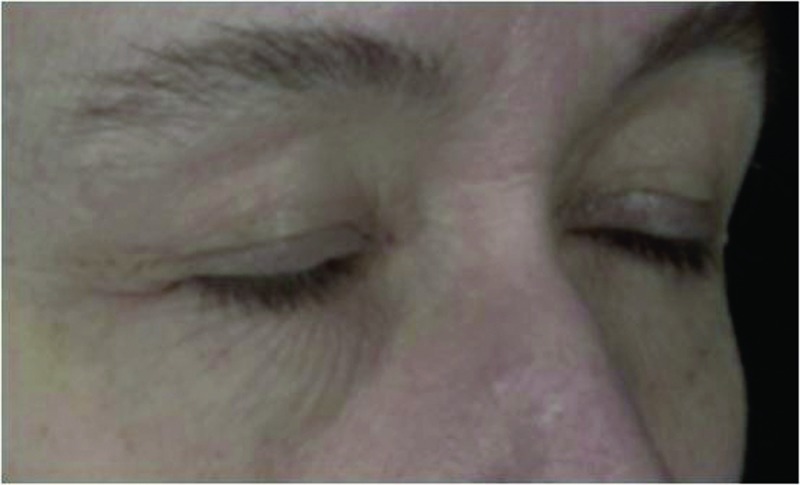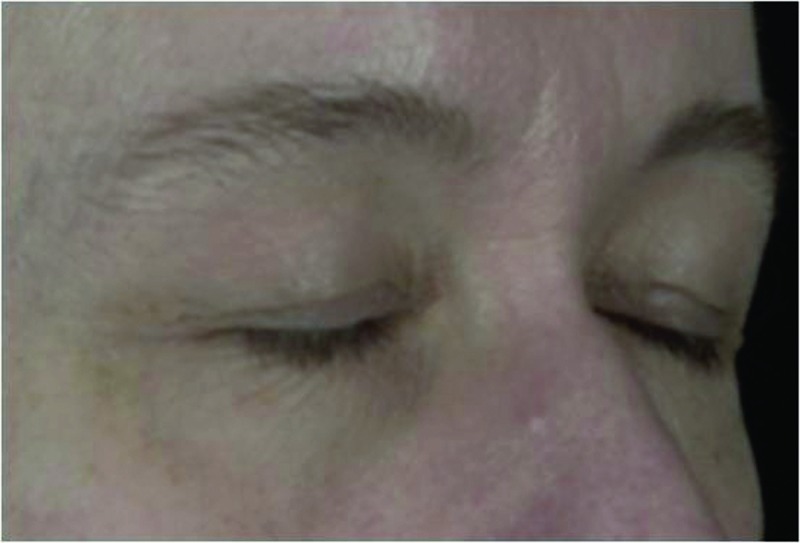Abstract
Background: The aim of this study was to evaluate the efficacy of a new topical low molecular nano-hyaluronic acid preparation in treating wrinkles, skin hydration, and skin elasticity in humans. Methods: Thirty-three women with an average age of 45.2 were studied for a period of eight weeks to measure the anti-wrinkle efficacy of a new nano-hyaluronic acid. The measurements were performed in the periorbital regions by investigating the three-dimensional structure using a DermaTOP for wrinkles, Corneometer for skin hydration, Cutometer for skin elasticity, and a Chroma Meter for erythema. Thereafter, standardized images were taken and evaluated by six selected and trained raters at the end of the study for reduction of visible wrinkles as well as skin color uniformity and pigmentation. Results: The results of the study showed a statistically significant moisturizing effect of the product range (lotion, serum, and cream, after 2,4, and 8 weeks of treatment. Measurement of skin roughness showed a significantly finer skin structure after two weeks of treatment, and skin elasticity showed a significant improvement after 2 and 8 weeks of treatment. Conclusion: The new nano-hyaluronic acid clearly demonstrated a significant benefit in decreasing the depth of wrinkles (up to 40%), and skin hydration (up to 96%) and skin firmness and elasticity were significantly enhanced (up to 55%) at the end of eight weeks.
Hyaluronic acid (HA) plays a vital role in the synthesis of extracellular matrix molecules and epidermal cell interaction with the surrounding environment. It modulates cellular immunity by preventing infections and impeding allergic phenomena. One of its most important properties is that it can attach and hold large amounts of moisture; approximately 6L of water in just lg. Hyaluronic acid is said to be an ultimate solution for moisture retention of the skin. Youthful skin is hydrated because it contains large amounts of HA in the dermis. However, as we age, the amount of HA in the skin decreases and by the time we become adults, this amount decreases to five percent of baseline.
The challenging characteristic of conventional HAs in the use of topically applied anti-aging preparations has been that its molecules are 3,000nm in diameter, whereas the intercellular space is only 15 to 50nm and just 6 to lOnm at the hyaline membrane.1 This makes it impossible for conventionally produced HA to penetrate into deep layers of the dermis.2
Until recently, invasive methods, such as biorevitalization and mesotherapy, were considered to be the only way to deliver HA across the skin barrier. Scientists at Forlle’d Laboratories in Japan managed to reduce the size of HA molecules without disturbing their constituent subunit structure to a nano size (5nm), enabling the HA to cross the skin barrier deep into the dermal level. This was measured and verified by applying mass spectrometry analysis, a method developed by Dr. Koichi Tanaka, the scientist from Shimadzu (Japan) who won the Nobel Prize for his discovery in 2002. Now that the particle size is confirmed to be nano, scientists decided to conduct a clinical study to verify the efficacy of the product in humans.
Figure 1.

Baseline photo—before treatment
Figure 2.

Day 57 photo—after nano-hyaluronic acid treatment
OBJECTIVE
The aim of the study was to assess the anti-wrinkle efficacy of a cosmetic product before and after a period of product application compared to the untreated area. The long-term effects were for a period of eight weeks. The measurements were performed in the periorbital regions of female volunteers by investigating the three-dimensional structure of the wrinkles (DermaTOP, Eotech SA, France), skin hydration (Corneometer, CM825, Courage & Khazaka, Germany), skin elasticity (Cutometer, Courage+Khazaka electronic GmbH, Germany), and erythema (Chromameter, Minolta CR 300, Konica Minolta, Ramsey, New Jersey) on the bones of the cheeks. Additionally, standardized images were taken and evaluated by six select and trained raters at the end of the study for reduction of visible wrinkles as well as skin color uniformity and pigmentation.
SUBJECTS
Thirty-three subjects were enrolled in the study. All were women and the average age was 45.2±3.9 years old.
MATERIALS AND METHODS
The study was undertaken at proDERM Institute for Applied Dermatological Research in Hamburg Germany from January 5 to March 2, 2012. Dr. Mazen Raydan was the project coordinator for Forlle’d Skin Care Company, Tokyo, Japan. The study was conducted according to the study protocol and approximating the main principles of Good Clinical Practice. On Day 1, subjects came to the test site, were informed about the study, and gave their written consent. They were placed in a climatized room for at least 30 minutes. Baseline measurements were performed on the test areas using the following instruments: DermaTOP, Corneometer, Cutometer, and Chromameter. The product (nano-hyaluronic acid) was issued to the subjects with instruction to use twice daily on the assigned test area. After two weeks of product application at home, the patients returned to the study site. Instrument measurements and images were taken. Subjects were released and continued product application twice daily and returned to the study site on Day 29 where measurements and images were repeated. Subjects were once again released and instructed to continue to use the product for four more weeks. At Day 57, all subjects returned to the center where measurements and images were repeated. After the end of the study, six selected and trained raters ranked the macro photos according to the severity of wrinkles in the test areas.
VISUAL EVALUATION (EXPERT RATER)
The selected and trained raters ranked the macro photos by side according to the visible wrinkles in the periorbital region as well as the skin of color uniformity and pigmentation at the end of the study. The macro photos of one test site was shown blinded to the expert raters for one rating, so that the expert raters did not know the original time course when the photos were taken. The following scale was used: l=best rating to 4=worst rating. Scores were directly entered into a computer program system.
The test products that were used (nano-hyaluronic acid in a cream, serum, and lotion) were supplied by the sponsor of the study (Hyalogy® Skincare, DermAvance Pharmaceuticals Inc., Malvern, Pennsylvania). The test materials were applied by the subjects at home, twice daily accordingly to the following instruction: 1 to 1.5mL of the lotion was mixed with 3 to 4 drops of the serum directly in the palm of the hand and applied all over the face, including the periorbital region. After absorption of this mixture into the skin, a fingertip (no more than lmL) of the cream was applied to the skin (see Table 1 for the test schedule).
TABLE 2.
Mean values of difference to Day 1 and results for the comparison of treatments by paired t-tests (n=33)
| TIME | TREATMENT | MEAN VALUES OF DIFFERENCES TO DAY 1 | COMPARISONS OF TREATMENTS ON DIFFERENCES TO BASELINE: p-VALUES OF PAIRED t-TEST |
|---|---|---|---|
| Day 15 | A | -3.20 | 0.032* |
| B | 1.23 | ||
| Day 29 | A | -3.36 | 0.005* |
| B | 2.69 | ||
| Day 57 | A | -1.39 | <0.001* |
| B | 6.65 |
*=significant, p≤0.05
TABLE 1.
Test schedule
| DAY | |||||||
|---|---|---|---|---|---|---|---|
| 1 | 2-14 | 15 | 16-26 | 29 | 30-56 | 57 | |
| Acclimatization | X | X | X | X | |||
| Images | X | X | X | X | |||
| DermaTOP measure | X | X | X | X | |||
| Chromameter measure | X | X | X | X | |||
| Corneometer measure | X | X | X | X | |||
| Cutometer measure | X | X | X | X | |||
| Apply product (2x daily) | X | X | X | X | X | X | X |
| Visual rankings (photos) | X | ||||||
RESULTS
A Chromameter was used to measure erythema. Lower values were measured on Days 15 and 57 in comparison to baseline. Statistically significant differences were observed on Day 57 versus Day 1 (P<0.001).
Measurement of hydration of the upper skin layer (stratum corneum) was performed by the electrical capacitance method with a Corneometer. An increase of Corneometer values shows a skin moisturizing effect. On the area treated with nano-hyaluronic acid, skin hydration continuously increased throughout the course of the study versus baseline at Days 15, 29, and 57.
Skin topography was measured by capturing the three-dimensional surface structure of the skin with a charge coupled device camera using profilometry. After 15 days of treatment with nano-hyaluronic acid, roughness of the skin structure was significantly decreased and then remained on a comparable level throughout the course of the study. On the untreated area, roughness average (Ra) remained comparable throughout the course of the study.
Skin firmness was measured with a Cutometer. The measuring principle is based on a suction method. Using an optical measuring system, how far the skin was sucked into the measuring head was detected; this value gives a measure of skin elasticity. On Days 15 and 57, the increase of relative elastic recovery of the skin (r7) in comparison to baseline (Day 1) was significantly higher on the area treated with nano-hyaluronic acid than on the untreated area.
CONCLUSION
Summarizing the results of the study, a statistically significant moisturizing effect was observed with nano-hyaluronic acid in the full product range—cream, serum, and lotion. After 2,4, and 8 weeks of treatment, the skin was significantly more hydrated than the untreated skin. Measurement of skin roughness showed a significantly finer skin structure (Ra) after two weeks of treatment with the full product range. In addition, an improvement of skin elasticity (r7) was measured in comparison to untreated skin and demonstrated a significant improvement after two weeks of treatment and continued throughout the study.
The observation in this study was confirmed by previous studies that have incorporated the use of HA topically and have shown or demonstrated that the smaller the molecular weight of the active, the greater skin penetration and skin hydration observed in a controlled setting.3
Footnotes
DISCLOSURE:The authors report no relevant conflicts of interest.
REFERENCES
- 1.Desai P, Patlolla R, Singh M. Interaction of nanoparticles with the skin. Mol Membr Biol. 2010;27(7):247–259. doi: 10.3109/09687688.2010.522203. [DOI] [PMC free article] [PubMed] [Google Scholar]
- 2.Balaza EA, Band P. Hyaluronic acid: its structure and use. Cosmetic and Toiletries. 1984;99:65–72. [Google Scholar]
- 3.Pavicic T, Gauglitz GG, Lersch P, et al. Efficacy of cream based formulations of hyaluronic acid of different molecular weights in anti-wrinkle treatment. J Drugs Dermatol. 201110(9):990–1000. [PubMed] [Google Scholar]


